VisTool RP - Co-Mixer
The Co-Mixer page provides access to control the Co-Mixer system. The Co-Mixer is a 16x12 mono matrix summing mixer.

To assign a Co-Mixer input to a Co-Mixer bus touch the crosspoint button that corresponds to the assignment you wish to make.
Each Co-Mixer input has a level control which affects all bus send levels.
Co-Mixer Inputs and Bus can also be placed into the PFL bus and will use the normal PFL bus.
If a Co-Mixer input has been switched to being an additional Talkback input, any active Co-Mixer bus assigns will be disabled, and the Co-Mixer input will no longer be usable in the Co-Mixer.

AutoMix
Automix can be enabled for any of the 16 Co-Mixer inputs. Once enabled, an internal algorithm monitors the signal power of each channel, and then automatically adjusts the mix levels accordingly. For example, if there are three guests and a host, the algorithm automatically mutes the guest sources while the host is speaking. The feature is ideal for balancing active and inactive microphones, such as in a panel discussion, or creating an automated voice-over.
For each source, there are four parameters:
- Group - assigns the source to an automix group (from 1 to 8).
- AMix - enables (or disables) the automix function. When disabled, the mix level is adjusted manually from the source fader.
- Weight – sets the weighting factor of the source, from +9 to -9 with a default midpoint = 0.
- Speed – sets the "smoothness" of the automixing, in milliseconds (ms).
- Floor - defines the minimum level that the signal volume can be set to by the AutoMix.
- Passive Mode - prevents the channel from affecting other signals in the same AutoMix group. The channel itself will still be controlled by the AutoMix.
Sources with a higher weight value get priority in the mix; those with the same weight are mixed equally; those with a lower value get reduced priority. For example, in a panel discussion, you might want to give the host leading the discussion a higher weight value than that of the guests. Or, to create an automated voice-over, adjust the weight of the playout material to a much lower value than that of the voice.
The speed defines how quickly a signal returns to its normal mix level after its gain has been suppressed. A short speed fades signals in and out quickly but could result in "pumping" if several guests are talking in parallel. A longer speed will be smoother but may generate audible fades in and out. The ideal value depends on the material.
